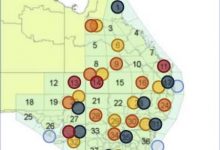The current rate of Australian solar PV, wind power and battery deployment is inspiring. Given our global climate crisis, the expansion of renewable energy offers hope that here in Australia we have finally begun to act.
But will the current pace be maintained… and even accelerated?
Where is the up-to-date plan that guides us… and shows how greenhouse-gas emissions from the electricity sector can be reduced as quickly as possible … all the way to zero?
The Australian Energy Market Operator (AEMO) is the organisation responsible for planning aspects of eastern-Australia’s electricity grid (known as the National Electricity Market or NEM). AEMO recently published an Integrated System Plan (ISP).
Unfortunately, the emission reductions described in the ISP aren’t enough.
Readers may recall that many Prime Ministers ago, in 2013, AEMO published the “100 Per Cent Renewables Study”. That report described how the eastern-Australian electricity grid could be supplied only by renewable energy, by as early as 2030.
AEMO’s study included a comprehensive survey of the renewable energy-generation and energy-storage resources of eastern Australia. Then, using sophisticated least-cost system modelling, AEMO matched those resources with renewable energy technologies and scenario-based forecasts of electricity demand.

Whereas still today some politicians and naysayers persist in claiming that operating a large electricity grid on renewable energy is technically impossible, AEMO’s 2013 report broke through when it “found that operational issues appear manageable“.
Since 2011, when AEMO was first commissioned to do the “100 Per Cent Renewables Study” by the Australian Government of the day, much has changed in the renewable-energy industry.
Thanks to falling costs, a repeat of that study would today factor in higher levels of solar PV, pumped hydro and batteries. Technologies such as geothermal that have not progressed down the cost curve in Australia would see little or no role in our future electricity grid.
Interestingly, AEMO’s landmark study was never supported by its board nor by senior AEMO management. Rather, it merely fulfilled a “footnote” requirement set by the Greens in the Julia Gillard Government’s Clean Energy Future Plan of July 2011.
With a subsequent change to a Tony Abbott-led government, AEMO’s pioneering work, along with other entities such as the Climate Commission and the carbon price, has nearly disappeared from memory.
It is only now that AEMO, under the new CEO Audrey Zibelman from the United States, have published a strategic report that resembles the 2013 “100 Percent Renewables Study”.
AEMO’s 2018 Integrated System Plan (ISP) describes seven scenarios and sensitivities where renewable energy and energy storage grows to the year 2040 – the approximate end of AEMO’s prescribed 20-year planning window.
With more detail in some areas than the 2013 “100 Percent Renewables Study”, the ISP describes, amongst many other things,
- a schedule for closure of some coal plants
- 30 renewable energy zones (REZs) across eastern Australia
- a specific sequence of key electricity-transmission infrastructure that must be built to support the transition.

AEMO’s ISP modelling tends to reflect only current federal and state government policies. Significant (but not-yet-approved) energy storage projects such as “Snowy 2.0” and Tasmania’s “Battery of the Nation” are nonetheless also factored in to the ISP.
In its ISP, AEMO assume, in the absence of other announcements, that coal plants will have a 50-year life span. By 2040, AEMO assume that eight coal plants close, from Liddell in New South Wales to Callide B in Queensland. No new coal plants will be built. But still in 2040, AEMO assume that another eight coal plants remain in operation with generation capacity totalling about 9 gigawatts (GW).
By 2040, the amount of electricity generated by solar PV and wind grows to be six times larger than it is today. Regarding climate impacts, AEMO’s scenarios indicate that 2040 greenhouse-gas emissions from the electricity-generation sector fall to about one-third of today’s levels.
Unfortunately, the remaining electricity-sector emissions caused by the 9 GW of coal-burners assumed to still be operating in 2040 isn’t good enough. People are already dying because of climate breakdown.
To minimise further deaths and damage, all nations must urgently reduce greenhouse-gas emissions as far as possible and as soon as possible. AEMO’s ISP falls short of telling us the whole story of what actually needs to be done.
The Australian Greens suggest that emissions in the electricity sector can be reduced by 90% by 2030. Recent research at the Australian National University (ANU) shows “Australia could have 100 per cent renewable electricity by the early 2030s if the current rate of installations by industry continues into 2020 and beyond”.
AEMO, as the official electricity-network planner, should publish an updated 100%-renewable energy plan, with an emphasis on minimising the Australian electricity sector’s contribution to climate breakdown.
Tim Forcey is an independent energy advisor. As Principal at AEMO in 2012, Tim was responsible for providing the resource and technology assessment and other input information for AEMO’s “100 Per Cent Renewables Study”.










